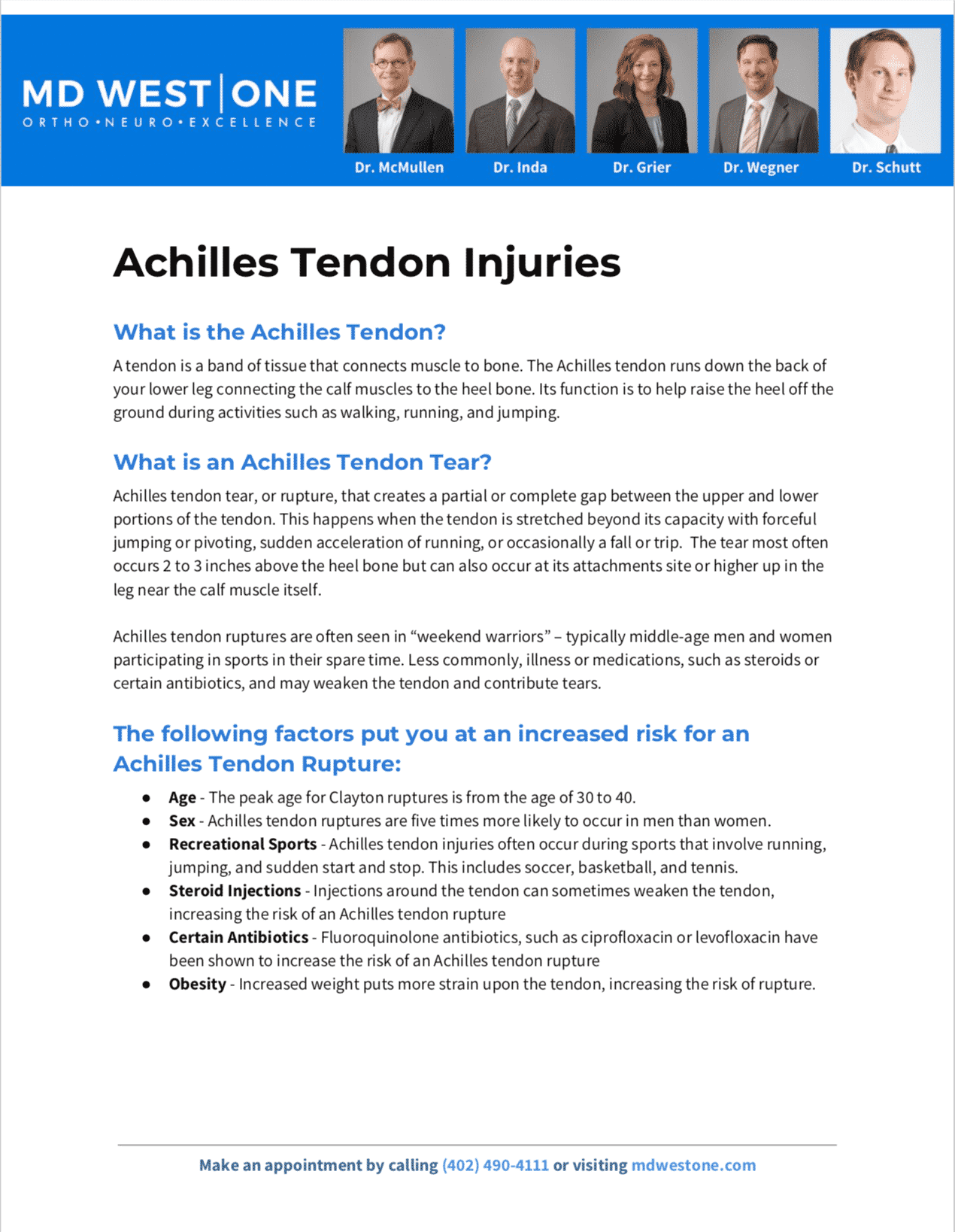Are you suffering from heel pain?
The Omaha Foot & Ankle Specialists at MD West ONE are able to properly diagnose and treat heel pain through both surgical and non-surgical treatments. If you have the following symptoms, you may want to make an appointment with one of our Board Certified Specialists.
- Pain on the bottom of the heel, or nearby
- Increased pain after exercise (not during)
- Pain in the arch of the foot
- Pain that is worse in the morning or when you stand after sitting for a long time
- A swollen heel
- Pain that continues for months
- A tight Achilles tendon (80% of people report this symptom.) Your Achilles tendon connects your calf muscles to your heel.
Meet MD West ONE's foot and ankle specialists and learn more about how they treat heel pain.
Heel Pain Causes, Treatments & Surgery
What is Heel Pain?
An inflamed heel is very painful. Imagine walking around with a strong ache in your heel, a tender bruise on the bottom of your foot, or a stabbing pain that hits you the moment your feet hit the ground in the morning. Now, if you already have it, imagine your pain beginning to go away or disappearing altogether — this too can happen.
The normal foot has 28 bones, 33 joints and more than 100 muscles, tendons and ligaments. It does so much! The heel itself supports the arch of your foot. It absorbs pressure — think of the shock absorbers of your car. It bears your weight. Pain is inevitable when the tissues are inflamed, or partially or completely torn.
The following factors put you at an increased risk for Heel Pain:
-
You have high-arched feet or flat feet.
-
You wear shoes that do not support your feet (especially for a long time on a hard surface).
-
You are obese.
-
You are an athlete.
-
You are a runner or jumper.
-
You work or exercise on a hard surface.
-
You stand for prolonged periods of time.
-
You exercise without stretching your calves.
Ways to Decrease Your Risk of Developing Heel Pain:
- Tape your arches.
- Stretch your feet, calves, and Achilles tendon.
- Ice your foot.
- Get plenty of rest.
- Do a low-impact exercise, like swimming, that does not put pressure on your feet.
- Change your shoes regularly if you are a walker or a runner.
DIAGNOSIS
Your healthcare provider will, after noting your medical history, perform a physical examination of your foot. If putting pressure on the heel causes pain, then heel pain is the likely culprit. If it is difficult to raise your toes, or if you have tingling or loss of feeling in your foot, those are big red flags.
They will ask questions like “is the pain worse in the morning?” and “does the pain typically decrease throughout the day and with use?” These and other affirmative answers to questions help your healthcare provider determine if it is heel pain.
Part of diagnosing heel pain is a process of elimination. Many conditions are considered when you report foot pain: a fracture, stress fracture, tendinitis, arthritis, nerve entrapment, or a cyst in the heel. To determine other possible causes, your healthcare provider may order imaging tests including:
- X-rays.
- Bone scans.
- Ultrasound.
- Magnetic resonance imaging (MRI).
NON-SURGICAL TREATMENT OPTIONS
Over 90% of those who have heel pain will improve within 10 months with the following at-home remedies. They include:
- Stretching your calf muscles.
- Wearing supportive, sturdy, well-cushioned shoes. Do not wear sandals or flip flops that do not have a built in arch support. Do not walk with bare feet.
- Using appropriate shoe inserts, arch supports, or custom-made foot orthotics.
- Using a night splint to reduce tightness in the calf muscle.
- Massaging the area.
- Putting ice on the area three to four times per day for 10 to 15 minutes.
- Limiting physical activity including prolonged standing.
- Taking over-the-counter nonsteroidal anti-inflammatory drugs (NSAIDs).
- Losing weight.
- Using crutches.
Outpatient treatments include:
- Cortisone (steroid) injections.
- Physical therapy for stretching and exercises.
- Extracorporeal shockwave therapy (ESWT). Shockwaves stimulate the healing process. This procedure is not commonly used.
- Seeing a podiatrist (foot specialist) for recommendations regarding insoles and shoes.
Occasionally, if none of the above solutions are effective after 12 months, surgery may be considered.
SURGICAL TREATMENT OPTIONS
There are two types of surgeries:
- Gastronemius recession. This surgery lengthens the calf muscles. Tight calf muscles put additional stress on the heel.
- Plantar fascia release. The plantar fascia is cut, partially, to relieve some of the tension.
Frequently Asked Questions?
How common is heel pain? Who gets it?
About one in 10 people will develop heel pain sometime in their lives. Young male athletes and middle-aged obese females get it most often.
Expect the worst pain when you first get out of bed in the morning and after you have been sitting for a long time. Expect that severe pain will be worsened by high-impact exercise, but remember that in most cases it is not permanent as long as you follow your treatment plan. Expect to have to change some of your behaviors to decrease symptoms.
How long will I have heel pain?
If the underlying reason for your heel pain is something you cannot help, like the fact that your foot is flat, permanent recovery is difficult. Continue to fight the symptoms with at-home remedies and recommendations from your healthcare provider.
AMERICAN ORTHOPAEDIC FOOT & ANKLE SOCIETY
All of the foot and ankle surgeons in the practice are recognized members of the American Orthopaedic Foot & Ankle Society. It is the oldest and most prestigious medical society dedicated to the foot and ankle. The mission of the society is to advance science and practice of foot and ankle surgery through education, research, and advocacy on behalf of patients and practitioners. These physicians dedicate their time and energy to improving the patient experience and their knowledge in their field. For more information visit http://www.aofas.org.
MD West ONE Foot & Ankle Specialists:
The Foot & Ankle Specialists are all Board Certified and Fellowship-Trained, meaning they’ve focused their education, training and research on orthopaedic surgery of the foot and ankle.






